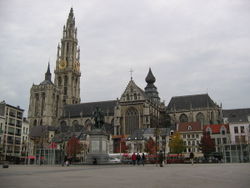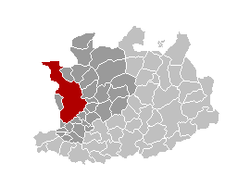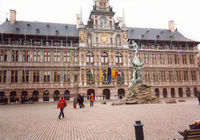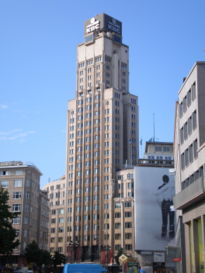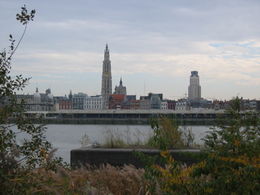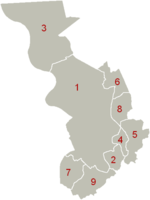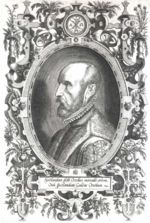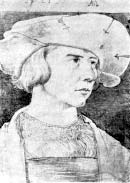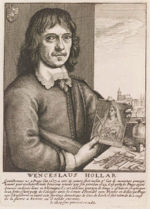Antwerp
2007 Schools Wikipedia Selection. Related subjects: European Geography
The city and municipality of Antwerp (Dutch: Antwerpen; French: Anvers; Spanish: Amberes) is a centre of commerce in Belgium and the capital of Antwerp province, in Flanders, one of Belgium's three regions. Antwerp's total population is ca. 461,496 (January 2006) and its total area is 204.51 km² with a population density of 2,257 inhabitants per km². The agglomeration has a population of about 800,000 ( municipality: 461,496 (2006), metropolitan area: ca. 1,225,000
Antwerp has long been an important city in the Low Countries both economically and culturally. It is on the right bank of the river Scheldt which is linked to the North Sea by the Westerschelde. Antwerp's port, which is one of the world's largest, has a high level of cargo shipping and oil refineries traffic, and in Europe, only Rotterdam 's ports is larger. Families of the large Hasidic Jewish community have traditionally controlled Antwerp's global centre of the diamond trading industry, though recently also Indian traders became involved.
Buildings and facilities
In the 16th century Antwerp was noted for the wealth of its citizens ("Antwerpia nummis"); the houses of these wealthy merchants and manufacturers have been preserved throughout Antwerp. Fire has destroyed several old buildings in the city, such as the house of the Hansa League on the northern quays in 1891.
- The Antwerp Zoo was founded in 1843, and home to more than 4,000 animals.
- Central Station is a railway station designed by Louis Delacenserie that was completed in 1905. It has two monumental neo-baroque facades, a large metal and glass dome (60m/197ft) and a gilt and marble interior.
- Cathedral of Our Lady. This church was begun in the 14th century and finished in 1518. The church has three works by Rubens, viz. " The Descent from the Cross," " The Elevation of the Cross," and " The Assumption."
- The church, named for St James, is more ornate than the cathedral. It contains the tomb of Rubens.
- The church of St Paul, has a beautiful baroque interior. It is a few hundred yards north of the Grote Markt.
- The Plantin-Moretus Museum preserves the house of the printer Christoffel Plantijn and his successor Jan Moretus.
- The Boerentoren (Farmers' Tower) or KBC Tower is the oldest skyscraper in Europe
- The Koninklijk Museum voor Schone Kunsten (Royal Museum for Fine Arts) close to the southern quays has a collection of old masters (Rubens, Van Dyck, Titian) and the leading Dutch masters. The exchange or Bourse, one of the early institutions in Europe with that title, was built in 1872.
Antwerp had an artistic reputation in the 17th century, based on its school of painting, which included Rubens, Van Dyck, Jordaens, the two Teniers and many others. Antwerpenaren (Antverpians, people from Antwerp) speak a dialect which is recognised by Dutch-speaking people because of its A-sound, which sounds more like the 'o' in bore.
Commerce
In 1863, Antwerp was opened again to international trade by the purchase of the Dutch right to levy tolls. Eight principal basins or docks already existed in 1908.
With the completion of the new maritime lock, ships drawing 30 feet of water would be able to enter these new docks and also the Lefebvre and America docks. The quays flanking the Scheldt are 3-½ miles in length, constructed of granite.
Transportation
Due to its importance as a one of Europe's biggest ports and its central location in Europe and within Belgium the city has impressive infrastructure and is easily reached from all directions by car and train.
Car
Highways lead to Brussels, Hasselt, Liège, Breda (Netherlands), Ghent and Bruges. They are led around the city by the Ring. Both banks of the Scheldt are connected to each other by several tunnels, the oldest of which is the Waaslandtunnel ( 1934), on the Ring the Kennedytunnel connects the left with the right bank and in the North between the docks there is the Liefkenshoektunnel. Currently a fourth cartunnel is being planned on the northern part of the Ring which to be completed in 2012.
Rail
Antwerp has two main stations: Centraal and Berchem. Central Station (1905) is a monument in itself. As Central Station is the end of the line many trains only stop at Berchem Station. From Berchem Station international trains go to Amsterdam, Paris and Lille, national trains go directly to Ghent, Ostend, Brussels, Charleroi, Hasselt, Liège and Turnhout.
City transportation
Antwerp has a fine web of tram and bus lines providing good acces to the suburbs and the Left Bank. The tram network has 11 lines and is partly underground. This part is thus called the premetro.
Air
Antwerp international airport is located in the district of Deurne. VLM Airlines flies to London (City Airport) and Manchester in England. VLM is the only airline with scheduled air services to and from Antwerp International Airport. The airport is connected by bus to the city centre.
Fortifications
Although Antwerp was formerly a fortified city, nothing remains of the former enceinte or of the old citadel defended by General Chassé in 1832, except for the Steen, which has been restored. Modern Antwerp's broad avenues mark the position of the original fortifications.
After the establishment of Belgian independence, Antwerp was defended by the citadel and an enceinte around the city. In 1859, seventeen of the twenty-two fortresses constructed under Wellington's supervision in 1815- 1818 were dismantled and the old citadel and enceinte were removed. A new enceinte 8 miles long was constructed, and the villages of Berchem and Borgerhout, now parishes of Antwerp, were absorbed within the city.
This enceinte is protected by a broad wet ditch, and in the caponiers are the magazines and store chambers of the fortress. The enceinte has nineteen openings or gateways, but of these seven are not used by the public. As soon as the enceinte was finished eight detached forts from 2 to 2-½ miles from the enceinte were constructed. They begin on the north near Wyneghem and the zone of inundation, and terminate on the south at Hoboken. In 1870 Fort Merxem and the redoubts of Berendrecht and Oorderen were built for the defence of the area to be inundated north of Antwerp.
In the 1870s, the fortifications of Antwerp were deemed to be out of date, given the increased range and power of artillery and explosives. Antwerp was transformed into to a fortified position by constructing an outer line of forts and batteries 6 to 9 miles from the enceinte.
History
Origin of name
According to folklore, the city got its name from a legend involving a mythical giant called Antigoon that lived near the river Scheldt, exacting a toll from those crossing the river. On refusal, the giant severed one of their hands and threw them into the Scheldt. Eventually, the giant was slain by a young hero named Brabo, who cut off the giant's hand and threw it into the river. Hence the name Antwerpen from Dutch hand werpen (hand-throwing).
To support this folkloric derivation, it is pointed out that hand-cutting was practised in Europe, when the right hand of a man who died without heir was cut off and sent it to the feudal lord as proof of main-morte. However, Motley argues that Antwerp's name derives from an t werf (on the wharf), since the form Andhunerbo existed in the 6th century on the separation of Austrasia and Neustria (Encyclopaedia Britannica 1911).
Pre-1500
The historical Antwerp had its origins in a Gallo-Roman vicus civilization. Excavations carried out in the oldest section near the Scheldt, 1952 to 1961 (ref. Princeton), pottery sherds and fragments of glass from mid-second century to the end of the third century.
In the fourth century Antwerp was mentioned in Germania Secunda . The Merovingian Antwerp, now fortified, was evangelized by Saint Amand in the seventh century. At the end of the tenth century, the Scheldt became the boundary of the Holy Roman Empire. Antwerp became a margraviate, a border province facing the County of Flanders. In the eleventh century Godfrey of Bouillon was for some years best known as marquis of Antwerp.
In the twelfth century Norbert of Xanten established a community of his Premonstratensian canons at St. Michael’s Abbey at Caloes. Antwerp was the headquarters of Edward III during his early negotiations with Jacob van Artevelde, and his son Lionel, the earl of Cambridge, was born there in 1338.
1500s
After the closing of the Zwyn and the consequent decline of Bruges, the city of Antwerp, then part of the Duchy of Brabant, became of importance. At the end of the 15th century the foreign trading houses were transferred from Bruges to Antwerp, and the building assigned to the English nation is specifically mentioned in 1510.
Fernand Braudel states that Antwerp became "the centre of the entire international economy—something Bruges had never been even at its height." (Braudel 1985 p. 143.) Antwerp's "Golden Age" is tightly linked to the " Age of Exploration". Over the first half of the 16th century Antwerp grew to become the second largest European city north of the Alps by 1560. Many foreign merchants were resident in the city. Guicciardini, the Venetian envoy, stated that hundreds of ships would pass in a day, and 2000 carts entered the city each week. Portuguese ships laden with pepper and cinnamon would unload their cargo.
Without a long-distance merchant fleet, and governed by an oligarchy of banker-aristocrats forbidden to engage in trade, the economy of Antwerp was foreigner-controlled, which made the city very international, with merchants and traders from Venice, Ragusa, Spain and Portugal. Antwerp had a policy of toleration, which attracted a large orthodox Jewish ( hasidic) community. Antwerp was not a "free" city though, since it had been reabsorbed into the duchy of Brabant in 1406 and was controlled from Brussels.

Antwerp experienced three booms during its century, the first based on the pepper market, a second launched by American silver coming from Seville (ending with the bankruptcy of Spain in 1557), and a third boom, after the stabilising Treaty of Cateau-Cambresis, in 1559, based on the textiles industry. The boom-and-bust cycles and inflationary cost-of-living squeezed less-skilled workers.
The religious revolution of the Reformation erupted in violent riots in August 1566, as in other parts of the Netherlands. The regent Margaret, duchess of Parma was swept aside when Philip II sent the Duke of Alva at the head of an army the following summer.
When the Eighty Years' War broke out in 1572, commercial trading between Antwerp and the Spanish port of Bilbao was not possible. On November 4, 1576, the Spanish soldiers plundered the city. During the Spanish Fury 6000 citizens were massacred, 800 houses were burnt down, and over two millions sterling of damage was done.
Antwerp became the capital of the Dutch revolt. In 1585 Alessandro Farnese, Duke of Parma and Piacenza captured it after a long siege and sent its Protestant citizens into exile. Antwerp's banking was controlled for a generation by Genoa and Amsterdam became the new trading centre.
1600s
The recognition of the independence of the United Provinces by the treaty of Munster in 1648 stipulated that the Scheldt should be closed to navigation, which destroyed Antwerp's trading activities.
1800s
This impediment remained in force until 1863, although the provisions were relaxed during French rule from 1795 to 1814, and also during the time Belgium formed part of the kingdom of the Netherlands ( 1815 to 1830). Antwerp had reached the lowest point of its fortunes in 1800, and its population had sunk under 40,000, when Napoleon, realizing its strategical importance, assigned two millions for the construction of two docks and a mole.
In 1830 the city was captured by the Belgian insurgents, but the citadel continued to be held by a Dutch garrison under General David Hendrik Chassé. For a time this officer subjected the town to a periodical bombardment which inflicted much damage, and at the end of 1832 the citadel itself was besieged by a French army. During this attack the town was further injured. In December 1832, after a gallant defence, Chassé made an honourable surrender.
1900s
During World War I, the city became the fallback point of the Belgian Army after the defeat at Liège. It was taken after heavy fighting by the German Army, and the Belgians were forced to retreat westward.
During World War II the city was occupied by Germany and was liberated on September 4, 1944 when the British 11th Armoured Division entered the city. After this, the Germans attempted to destroy the Port of Antwerp, which was used by the Allies to bring new material ashore. The city was hit by more V-2 rockets than any other target during the entire war, but the attack did not succeed in destroying the port since many of the missiles fell upon other parts of the city. Also many V-1 and some V-2 missiles battered the city. As a result, the city itself was severely damaged and rebuilt after the war in a modern style.
Antwerp also hosted the 1920 Summer Olympics and was the first city to host the World Gymnastics Championships, in 1903.
After the war, Antwerp, which had already had a sizable Jewish population before the war, became a major European centre of Haredi (and particularly Hassidic) Orthodox Judaism.
Historical population
This is the population of the city of Antwerp only, not of the larger current municipality of the same name.
- 1374: 18,000
- 1486: 40,000
- 1500: around 44/49,000 inhabitants
- 1526: 50,000
- 1567: 105,000 (90,000 inhabitants and 15,000 strangers)
- 1575: around 100,000 (after the Inquisition)
- 1584: 84,000 (after the Spanish Fury, the French Fury and the calvinistic republic)
- 1586 (May): 60,000 (after siege)
- 1586 (October): 50,000
- 1590: fewer than 40,000
- 1591: 46,000
- 1612: 54,000
- 1620: 66,000 ( Twelve Years' Truce)
- 1640: 54,000 (after the Black Death epidemics)
- 1700: 66,000
- 1765: 40,000
- 1784: 51,000
- 1800: 45,500
- 1815: 54,000
- 1830: 73,500
- 1856: 111,700
- 1880: 179,000
- 1900: 275,100
- 1925: 308,000
- 1959: 260,000
Municipality
The municipality comprises the city of Antwerp proper and several towns. So it can be divided into nine entities (districten in Dutch):
- Antwerp (district)
- Berchem
- Berendrecht-Zandvliet-Lillo
- Borgerhout
- Deurne
- Ekeren
- Hoboken
- Merksem
- Wilrijk
Sister cities
The following places are sister cities to Antwerp:
 Mulhouse, France, 1954
Mulhouse, France, 1954 Saint-Petersburg, Russia, 1958
Saint-Petersburg, Russia, 1958 Shanghai, China, 1984
Shanghai, China, 1984 Haifa, Israel, 1995
Haifa, Israel, 1995 Capetown, South Africa, 1996
Capetown, South Africa, 1996 Barcelona, Spain, 1997
Barcelona, Spain, 1997 Ludwigshafen, Germany, 1998
Ludwigshafen, Germany, 1998
Within the context of development cooperation, Antwerp is also linked to:
 Paramaribo, Suriname
Paramaribo, Suriname Durban, South Africa
Durban, South Africa
This list does not include relationships of the subordinate districten with cities abroad.
People who were born or have lived in Antwerp
See also: Notable people from Antwerp
Born in Antwerp
- Lionel of Antwerp, 1st Duke of Clarence, son of Edward III of England (1338-1368)
- Frans Floris, painter (1520-1570)
- Abraham Ortelius, cartographer and geographer (1527-1598)
- Gillis van Coninxloo, painter of forest landscapes (1544-1607)
- Bartholomeus Spranger, painter, draughtsman, and etcher (1546-1611)
- Paul and Mattheus Brill, landscape painters (1554-1626, 1550-1583, resp.)
- Abraham Janssens, painter (c. 1570-1632)
- Rodrigo Calderón, Count of Oliva, Spanish favourite and adventurer (d. 1621)
- Franz Snyders, still life and animal painter (1579-1657)
- Frans Hals, painter (1580-1666)
- Caspar de Crayer, painter (1582-1669)
- David Teniers the Elder, painter (1582-1649)
- Jacob Jordaens, painter (1593-1678)
- Anthony van Dyck, painter (1599-1641)
- David Teniers the Younger, painter (1610-1690)
- Jan Fyt, animal painter (1611-1661)
- Nicolaes Maes, Baroque painter (1634-1693)
- Gerard Edelinck, copper-plate engraver (1649-1707)
- John Michael Rysbrack, sculptor (1694-1770)
- Hendrik Conscience, writer and author of De Leeuw van Vlaanderen (“The Lion of Flanders”) (1812-1883)
- Georges Eekhoud, novelist (1854-1927)
- Hippolyte Delehaye, Jesuit and hagiographic scholar (1859-1941)
- Willem Elsschot, writer and poet (1882-1960)
- Constant Permeke, expressionist painter (1886-1952)
- Paul van Ostaijen, poet and writer (1896-1928)
Lived in Antwerp
- Quentin Matsys, Renaissance painter, founder of the Antwerp school (1466-1530)
- Jan Mabuse, painter (c. 1478-1532)
- Joachim Patinir, landscape and religious painter (c. 1480-1524)
- John Rogers, minister of religion, Bible translator and commentator, and martyr (c. 1500-1555)
- Joos van Cleve, painter (c. 1500-1540/41)
- Damião de Góis, Portuguese humanist philosopher (1502-1574)
- Sir Thomas Gresham, English merchant and financier (c. 1519-1579)
- Sir Anthony More, portrait painter (1520- c. 1577)
- Christoffel Plantijn, humanist, book printer and publisher (c. 1520-1589)
- Pieter Brueghel the Elder, painter and printmaker (1525-1569)
- Philip van Marnix, writer and statesman (1538-1598)
- Simon Stevin, mathematician and engineer (c. 1548/49-1620)
- John Bull, Welsh composer, musician, and organ builder (c. 1562-1628)
- Jan Brueghel the Elder, also known as “Velvet” Brueghel, painter (1568-1625)
- Pieter Paul Rubens, painter (1577-1640)
- William Cavendish, 1st Duke of Newcastle, English soldier, politician, and writer (c. 1592-1676)
- Adriaen Brouwer, painter (1605-1638)
- Jan Davidszoon de Heem, painter (1606-1684)
- Wenceslas Hollar, Bohemian etcher (1607-1677)
- Jan Lievens, painter (1607-1674)
- Jan Frans Willems, writer (1793-1846)
- Henri Alexis Brialmont, military engineer (1821-1903)
- Sir Lawrence Alma-Tadema, painter (1836-1912)
- Vincent van Gogh, impressionist painter, lived in Antwerp for about four months (1853-1890)
- Camille Huysmans, Socialist politician and former Prime Minister of Belgium (1871-1968)
Specific areas in Antwerp
- Zurenborg
- Van Wesenbekestraat – the Chinatown of Antwerp
- Meir – Antwerp's largest shopping street
- Den Dam – an area in northern Antwerp
